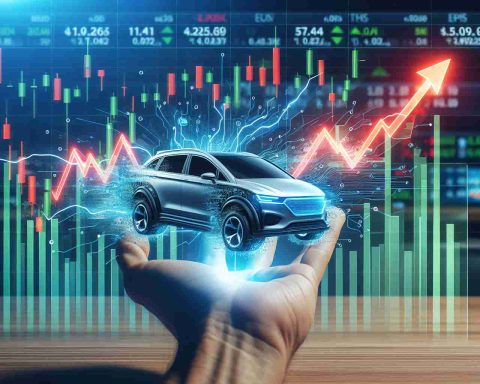Shocking Accident Marks a New Era in Self-Driving Technology
In a groundbreaking incident on Sunday evening in San Francisco, a multi-car accident involving a fully autonomous vehicle resulted in fatalities, raising concerns around the safety of self-driving technology. Reports indicate that a Waymo self-driving car, which was unoccupied at the time, was caught up in a chaotic scene when a speeding vehicle collided with several cars waiting for a green light at the intersection of 6th and Harrison Streets.
The incident led to the death of a passenger in one of the affected vehicles and a dog, with several others sustaining injuries as documented by local authorities. Although the Waymo vehicle was stationary during the crash, the intensity of the event has prompted questions about the safety protocols in place for autonomous technology.
The National Highway Traffic Safety Administration (NHTSA) keeps a record of accidents involving self-driving vehicles, but the details regarding fault can be ambiguous. Since July 2021, Waymo vehicles have been involved in numerous collisions, most attributed to human drivers. In a recent analysis, Waymo claimed its autonomous cars have fewer insurance claims related to accidents compared to human-operated vehicles, showcasing a positive safety trend.
The tragic event is reminiscent of a previous fatal incident involving autonomous technology in 2018, but this time marks a pivotal moment as it is the first fatal accident with a completely unattended driverless vehicle. As discussions about the future of autonomous driving continue, this incident undoubtedly brings safety concerns to the forefront.
The Broader Impact of Autonomous Vehicle Technology
The tragic accident in San Francisco not only underscores the immediate safety concerns surrounding self-driving vehicles but also casts a long shadow on the societal acceptance of autonomous technology. As a society grapples with the implications of this incident, questions arise about how self-driving cars will integrate into our daily lives, transportation ecosystems, and urban planning.
In terms of culture, the fear sparked by such accidents may hinder public adoption of self-driving technology, necessitating a cultural shift in how society perceives innovation versus safety. If trust in autonomous vehicle systems is compromised, there could be significant delays in the integration of self-driving cars, potentially stalling progress in reducing traffic congestion and lowering accident rates overall.
Environmental impacts also warrant consideration; autonomous vehicles hold promise for reducing emissions by optimizing driving patterns. However, public hesitance could slow the transition toward fleets of electric self-driving cars, which are pivotal in combating climate change. Future trends may see increasing regulation and monitoring of autonomous systems to ensure safety, but this could also create barriers to innovation.
Looking ahead, the long-term significance of such incidents may influence not just technology development but also policy-making as governmental bodies strive to ensure public safety while fostering innovation. Ultimately, the balance between embracing transformative technology and safeguarding human lives will define the future of autonomous driving.
Unraveling the Future: Lessons from the Latest Self-Driving Vehicle Accident
Introduction to the Shift in Self-Driving Technology Safety
The recent tragic accident involving a Waymo autonomous vehicle in San Francisco serves as a stark reminder of the ongoing challenges faced by self-driving technology. While the vehicle itself was not in motion during the incident, the repercussions highlight critical discussions around safety measures, accountability, and the future of autonomous cars.
Key Statistics and Trends in Autonomous Vehicle Safety
1. Accident Data: The NHTSA monitors accidents involving self-driving cars, documenting several incidents since their introduction. Industry reports indicate that autonomous vehicles are involved in fewer fatal accidents compared to traditional vehicles, primarily attributed to stringent software and hardware safety systems.
2. Insurance Implications: A comprehensive study revealed that Waymo’s autonomous vehicles generated approximately 70% fewer insurance claims than human-driven cars. This statistic emphasizes the potential benefits of incorporating autonomous technology into public roadways, provided that safety protocols are strictly enforced.
3. Growing Market: The self-driving technology market is projected to grow substantially over the next decade, with estimates suggesting it could reach $556 billion by 2026. As more companies invest in and develop autonomous systems, the focus on safety improvements becomes paramount to public acceptance.
Pros and Cons of Self-Driving Vehicles
# Pros:
– Reduced Human Error: Self-driving technology aims to minimize accidents caused by human errors, such as distractions or impaired driving.
– Traffic Efficiency: Autonomous vehicles can optimize route planning, potentially reducing traffic congestion.
– Increased Mobility: They provide greater independence for those unable to drive, such as the elderly or disabled individuals.
# Cons:
– Complex Decision-Making: The technology can struggle with complex traffic situations, leading to potential hazards.
– Public Trust: Incidents like the recent accident affect public confidence in the safety and reliability of self-driving cars.
– Ethical Dilemmas: Autonomous vehicles need to navigate moral decisions during accidents, raising ethical concerns that have yet to be addressed fully.
Innovations and Safety Features in Autonomous Vehicles
Autonomous vehicles are equipped with a variety of advanced safety features, including:
– LIDAR and Radar Systems: These technologies help detect obstacles, pedestrians, and other vehicles in real-time to ensure safe navigation.
– Machine Learning Algorithms: Continuous improvement via data analysis allows self-driving systems to learn from past incidents and adjust their safety protocols accordingly.
– Emergency Response Systems: Enhanced systems are designed to take manual control in critical situations or alert authorities when necessary.
Future Predictions for Autonomous Vehicle Safety Regulations
Experts predict that regulatory frameworks will become more stringent as technology evolves. Expect to see:
– Increased Testing Requirements: Guidelines for on-road testing of autonomous vehicles will likely become more rigorous to ensure safety and accountability.
– Implementation of Safety Standards: Regulatory bodies may introduce standardized safety certifications for all self-driving technologies before they hit the market.
– Greater Public Engagement: As incidents raise concerns, public forums will likely become essential for policymakers to engage with community members and address safety apprehensions.
Conclusion
The recent accident involving a Waymo vehicle underscores the critical need for ongoing improvements in self-driving technology and its regulatory environment. While the potential benefits of autonomous vehicles are considerable, addressing safety concerns through innovation, community engagement, and robust regulations will be vital for building public trust going forward.
For more information on the evolving landscape of self-driving technology, visit Waymo.














